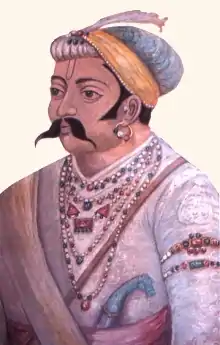Ратхор (клан)
Ратхор (хинди राठौड़) — это клан индуистских раджпутов, обитающий в Северной Индии[1]. Ратхор один из тридцати шести раджпутских кланов[2]. Альтернативные варианты написания включают Rathaur или Rathor или Rathur или Rathod или Rathour или Rahtore. Храбрость ратхорских всадников была высоко оценена савойским авантюристом Бенуа де Буанем после его военной кампании против них[3].

Ратхор как и другие раджпутские кланы по-разному претендуют на происхождение от Сурьяванши (Солнечной династии)[4]. Тем не менее, историки утверждают, что такое знатное происхождение не имеет исторических оснований, и было сфабриковано брахманами для того, чтобы дать, главным образом, неграмотным воинам из низших каст добиться повышения статуса и престижа в процессе, называемом Раджпутизация[5][6][7][8][9].
Ратхоры также утверждают, что являются потомками династии Гахадавала XI века в Варанаси[10][11]. Ратхоры из княжества Джодхпур утверждали, что являются потомками Джаячандры, раджи Антараведи (ок. 1170—1194). Заминдары феодального поместья Манда, которые называли себя Ратхор, прослеживали свою родословную до предполагаемого брата Джаячандры Маникячандры (Маник Чанд). Эти утверждения восходят к бардийским хроникам; например, согласно эпической поэме Prithviraj Raso, Ратхор был эпитетом Джаячандры (Джайчанда)[12]. Эти утверждения имеют более позднее происхождение, и их историческая достоверность сомнительна[13] . В средневековый период Гахадавалы были анахронично классифицированы как один из кланов раджпутов, несмотря на то, что раджпутская идентичность не существовала в их время[14][15].
Ратхорские княжества
Различные боковые ветви клана Ратхор постепенно распространились, чтобы охватить весь Марвар и позже основали государства в Центральной Индии и Гуджарате. Королевская семья Марвара считается главным домом Ратхоров. Во время независимости Индии в 1947 году княжеские государства, управляемые различными ветвями клана Ратхор, включали[16][17]:
- Джодхпур (Марвар) в современном Раджастане, основанный в 1459 году Рао Джодхой.
- Биканер в современном Раджастане, основанный в 1465 году Рао Бикаджи (сыном Рао Джодхи).
- Кишангарх в современном Раджастане, основанный в 1611 году Раджой Кишаном Сингхом.
- Идар в современном Гуджарате, основанный в 1729 году Рао Анандом Сингхом.
- Ратлам в современном штате Мадхья-Прадеш, основанный в 1651 году Махараджей Ратаном Сингхом.
- Джхабуа в современном штате Мадхья-Прадеш, основанный в 1584 году Раджой Кешавом Дасом.
- Ситамау в современном штате Мадхья-Прадеш, основан в 1701 году Раджой Кешо Дасом.
- Саилана в современном штате Мадхья-Прадеш, основанная в 1730 году Раджой Джай Сингхом.
- Алираджпур в современном штате Мадхья-Прадеш, основанный в 1437 году Раджой Анандом Део.
- Серайкела в современном Джаркханде, основанная в 1620 году Раджой Бикрамом Сингхом.
Примечания
- A. M. Shah. The Family in India: Critical Essays. — Orient Blackswan, 1998. — P. 112–. — ISBN 978-81-250-1306-8.
- A History of Rajasthan, Section:The Rathores of Marwar , pg.372, by Rima Hooja, ISBN 9788129108906 — «The Rathores are amongst the traditionally listed thirty-six Rajput clans.»
- Fall of the Mughal Empire: 1789—1803, Jadunath Sarkar, p 29 — «It is but just to the enemy to acknowledge that, considering the situation in which they were found, and the disorder consequent thereto, they behaved very valiantly»
- Indian India : [англ.]. — Director of Public Relations, Chamber of Princes, 1945-01-01.
- Koyal, Sivaji (1986). “Emergence of Kingship, Rajputization and a New Economic Arrangement in Mundaland”. Proceedings of the Indian History Congress. Indian History Congress. 47, I: 536—542. JSTOR 44141600.
- André Wink. Al-Hind, the Making of the Indo-Islamic World: Early Medieval India and the Expansion of Islam 7Th-11th Centuries. — BRILL, 2002. — P. 282. — «In short, a process of development occurred which after several centuries culminated in the formation of new groups with the identity of 'Rajputs'. The predecessors of the Rajputs, from about the eighth century, rose to politico-military prominence as an open status group or estate of largely illiterate warriors who wished to consider themselves as the reincarnates of the ancient Indian Kshatriyas. The claim of Kshatriyas was, of course, historically completely unfounded. The Rajputs as well as other autochthonous Indian gentry groups who claimed Kshatriya status by way of putative Rajput descent, differed widely from the classical varna of Kshatriyas which, as depicted in literature, was made of aristocratic, urbanite and educated clans...». — ISBN 0-391-04173-8.
- Norman Ziegler (1976). David Henige, ed. “History in Africa (vol.3)”. African Studies Association: 150.
: Rajputs were, with some exceptions, almost totally illiterate as a caste group
- Reinhard Bendix. Max Weber: An Intellectual Portrait. — Psychology Press, 1998. — P. 180–. — ISBN 978-0-415-17453-4.
- Brajadulal Chattopadhyaya. Origin of the Rajputs: The Political, Economic and Social Processes in Early Medieval Rajasthan // The Making of Early Medieval India. — Oxford University Press, 1994. — P. 59. — ISBN 9780195634150.
- Jadunath Sarkar, 1960, p. 32.
- Niyogi, 1959, p. 29.
- Niyogi, 1959, p. 30.
- Niyogi, 1959, pp. 30–31.
- Jackson, 2003, p. 9.
- Talbot, 2015, pp. 33–35.
- Indian Princely Medals: A Record of the Orders, Decorations, and Medals by Tony McClenaghan, pg 179
- Dhananajaya Singh. The House of Marwar. — Lotus Collection, Roli Books, 1994. — P. 13. — «He was the head of the Rathore clan of Rajputs, a clan which besides Jodhpur had ruled over Bikaner, Kishengarh, Idar, Jhabhua, Sitamau, Sailana, Alirajpur and Ratlam, all States important enough to merit gun salutes in the British system of protocol. These nine Rathore States collectively brought to India territory not less than 60,000 square miles in area.».
Источники
- Gopinath Sharma. Rajasthan Studies. — Agra, India : Lakshmi Narain Agarwal, 1970. — P. 201.
- Jadunath Sarkar. A History of Jaipur: C. 1503-1938 : [англ.]. — Orient Blackswan, 1994. — ISBN 978-81-250-0333-5.
- Bose, Melia Belli. Royal Umbrellas of Stone: Memory, Politics, and Public Identity in Rajput Funerary Art. — 27 August 2015. — P. 140. — ISBN 9789004300569.
- Niyogi, Roma. The History of the Gāhaḍavāla Dynasty. — Oriental, 1959.